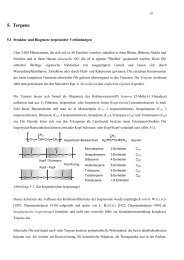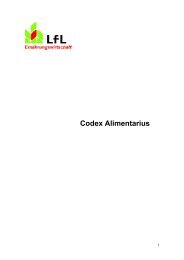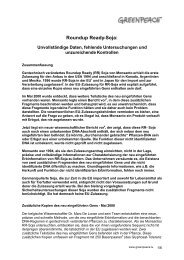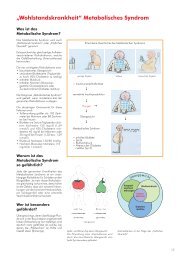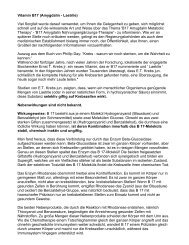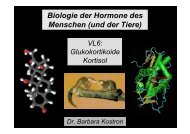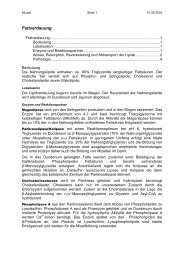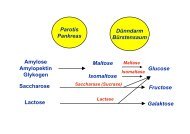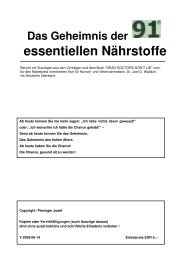Dietary Modulation of Omega-3/Omega-6 Polyunsaturated Fatty ...
Dietary Modulation of Omega-3/Omega-6 Polyunsaturated Fatty ...
Dietary Modulation of Omega-3/Omega-6 Polyunsaturated Fatty ...
You also want an ePaper? Increase the reach of your titles
YUMPU automatically turns print PDFs into web optimized ePapers that Google loves.
<strong>Dietary</strong> <strong>Modulation</strong> <strong>of</strong> <strong>Omega</strong>-3/<strong>Omega</strong>-6<br />
<strong>Polyunsaturated</strong> <strong>Fatty</strong> Acid Ratios in Patients With<br />
Breast Cancer<br />
Dilprit Bagga, Stefani Capone, He-Jing Wang, David Heber, Michael Lill,<br />
Linnea Chap, John A. Glaspy*<br />
Background: <strong>Polyunsaturated</strong> fatty acids <strong>of</strong> the omega-6 (-<br />
6) class, as found in corn and safflower oils, can act as precursors<br />
for intermediates involved in the growth <strong>of</strong> mammary<br />
tumors when fed to animals, whereas polyunsaturated<br />
fatty acids <strong>of</strong> the omega-3 (-3) class, as found in fish oil, can<br />
inhibit these effects. The effects <strong>of</strong> dietary intervention on<br />
the ratios <strong>of</strong> these fatty acids in breast and other adipose<br />
tissues have not previously been prospectively studied. Purpose:<br />
The present investigation was conducted to study the<br />
impact on the ratio <strong>of</strong> -3 and -6 polyunsaturated fatty<br />
acid in plasma and in adipose tissue <strong>of</strong> the breast and buttocks<br />
when women with breast cancer consume a low-fat diet<br />
and fish oil supplements. Methods: Twenty-five women with<br />
high-risk localized breast cancer were enrolled in a dietary<br />
intervention program that required them to eat a low-fat<br />
diet and take a daily fish oil supplement throughout a<br />
3-month period. Breast and gluteal fat biopsy specimens<br />
were obtained from each woman before and after dietary<br />
intervention. The fatty acid compositions <strong>of</strong> specimens <strong>of</strong><br />
plasma, breast fat, and gluteal fat were determined by gasliquid<br />
chromatography. Statistical analysis involved use <strong>of</strong> a<br />
two-sided paired t test. Results: After dietary intervention, a<br />
reduction in the level <strong>of</strong> total -6 polyunsaturated fatty acids<br />
in the plasma was observed (P
prospective studies have not supported this hypothesis [reviewed<br />
in (2)]. An intervention trial (3) <strong>of</strong> total fat reduction is under<br />
way. An alternative hypothesis, that the nutritional modulation<br />
<strong>of</strong> breast cancer risk is mediated via the balance <strong>of</strong> polyunsaturated<br />
fatty acids in the diet, has not been tested in prospective<br />
studies.<br />
Several lines <strong>of</strong> evidence have indicated that the various polyunsaturated<br />
fatty acids differ in their ability to affect mammary<br />
tumor formation and growth. In murine models with either 7,12dimethylbenz[a]anthracene-induced<br />
mammary tumors or tumors<br />
derived from human breast cancer cell lines growing in immunodeficient<br />
mice, diets containing large amounts <strong>of</strong> linoleic acid<br />
are linked with increased mammary tumor promotion and with<br />
more aggressive tumor characteristics (4,5). In these models, the<br />
addition <strong>of</strong> -3 polyunsaturated fatty acids to the diet can block<br />
the promoting effects <strong>of</strong> -6 polyunsaturated fatty acids (6,7). In<br />
addition, feeding <strong>of</strong> high-fat diets based on coconut or olive oils<br />
is less effective in promoting tumor growth (8,9). Although the<br />
exact mechanisms by which polyunsaturated fatty acids exert<br />
their effect on tumor cell growth have not been identified, it is<br />
thought that eicosanoids derived from arachidonic acid play an<br />
important role in these processes (10). Linoleic acid can be<br />
converted to arachidonic acid (20:4, -6) by desaturation and<br />
elongation reactions. Arachidonic acid is rapidly incorporated<br />
into membrane phospholipids by transacylases. Various exogenous<br />
stimuli, including many growth factors, result in the release<br />
<strong>of</strong> arachidonic acid from membrane phospholipids. Arachidonic<br />
acid is further metabolized by the cyclooxygenase<br />
systems to 2-series (prostaglandins <strong>of</strong> 2-series have two double<br />
bonds, and this is described by a subscript, e.g., PGE 2) prostaglandins<br />
or through the 5-lipoxygenase systems to leukotrienes<br />
and 5-hydroxy-eicosatetraenoic acid (11). Fish oils,<br />
containing high amounts <strong>of</strong> eicosapentaenoic acid and docosahexaenoic<br />
acid, can antagonize the overproduction <strong>of</strong> eicosanoids<br />
derived from -6 polyunsaturated fatty acids by competing<br />
as a substrate for both cyclooxygenase and lipoxygenase<br />
systems (12) and at the same time producing 3-series prostaglandins<br />
and 5-series leukotrienes (both <strong>of</strong> which are eicosanoids;<br />
those <strong>of</strong> 3- and 5-series have 3 and 5 double bonds,<br />
respectively, and are described by a subscript PGE 3 and LTB 5,<br />
respectively) (13). The cyclooxygenase pathway product endoperoxide<br />
is converted to 3-series prostaglandins whereas the<br />
lipoxygenase pathway product 5-hydroxy-eicosatetraenoic acid<br />
is metabolized to leukotrienes <strong>of</strong> the 5-series. Production <strong>of</strong><br />
eicosanoids are tightly controlled in normal cells. Eicosanoids<br />
are rapidly inactivated by catabolic enzymes but may reach<br />
higher levels in tumor tissue (14). It has been shown that the<br />
cyclooxygenase product, PGE 2, and the lipoxygenase products,<br />
leukotrienes B 4 and C 4 (15), may be associated with breast tumor<br />
promotion through their effects on signal transduction. In<br />
addition, large quantities <strong>of</strong> prostaglandins have been found in<br />
both human and animal tumors (15). In contrast, the 3- and<br />
5-series eicosanoids derived from eicosapentaenoic acid cause<br />
less tissue inflammation, and their net effect is to inhibit production<br />
<strong>of</strong> the active metabolites <strong>of</strong> arachidonic acid (16). Thus,<br />
the ratio <strong>of</strong> precursor fatty acids (eicosapentaenoic acid/<br />
arachidonic acid) may determine the spectrum <strong>of</strong> eicosanoids<br />
produced by the cell and thereby attenuate the biologic effects <strong>of</strong><br />
growth factor stimuli.<br />
<strong>Fatty</strong> acids in the plasma are derived from endogenous and<br />
exogenous sources. These fatty acids are incorporated into the<br />
intracellular stores and membrane phospholipids. The fatty acid<br />
composition <strong>of</strong> cell membrane phospholipids can influence the<br />
biosynthesis <strong>of</strong> eicosanoids during a cellular response to an extracellular<br />
stimuli (11). It is possible that the ratio <strong>of</strong> -3/-6<br />
fatty acids entering the cellular pool from dietary sources can<br />
alter the ratio <strong>of</strong> eicosanoid precursor fatty acids in membrane<br />
phospholipids. While most <strong>of</strong> the case–control studies (17-20)<br />
that have compared the fatty acid composition <strong>of</strong> breast and/or<br />
gluteal adipose tissue between women with breast cancer and<br />
those with benign breast disease have failed to show a difference<br />
in storage <strong>of</strong> -3 fatty acids, one study (21) has observed a lower<br />
percentage <strong>of</strong> docosahexaenoic acid in breast adipose tissue <strong>of</strong><br />
postmenopausal patients with breast cancer. Moreover, the considerations<br />
outlined above suggest that it is the ratio <strong>of</strong> -3/-6<br />
rather than the absolute amount <strong>of</strong> either family <strong>of</strong> polyunsaturated<br />
fatty acid that is relevant to the breast cancer problem. We<br />
can speculate that the ratios <strong>of</strong> fatty acids in various diets may<br />
explain the international differences in breast cancer risk, and it<br />
might be prudent to intervene to alter the -3/-6 ratios in the<br />
diet and the ratios <strong>of</strong> polyunsaturated fatty acids that can be<br />
maintained in tissue phospholipids. A recent study (22) investigated<br />
the correlation between the fatty acid content <strong>of</strong> adipose<br />
tissue <strong>of</strong> buttocks and breast cancer risk in postmenopausal<br />
women in five European countries. They found no correlation<br />
between the higher concentration <strong>of</strong> -6 polyunsaturated fatty<br />
acids in adipose tissue and breast cancer. The study suggested to<br />
us the possibility that the ratio <strong>of</strong> -3/-6 polyunsaturated fatty<br />
acids may provide a way to predict an increased risk <strong>of</strong> breast<br />
cancer.<br />
The fatty acid composition <strong>of</strong> adipose tissue reflects longterm<br />
dietary intake <strong>of</strong> fatty acids (23). <strong>Dietary</strong> fatty acid composition<br />
is reflected in the composition <strong>of</strong> stored triacylglycerols<br />
(24) and therefore may be subject to alteration by diet. This<br />
modification <strong>of</strong> stored fatty acids in breast fat could have important<br />
implications for breast cancer in view <strong>of</strong> the importance<br />
<strong>of</strong> breast adipocytes for storage and release <strong>of</strong> fatty acids that are<br />
required for normal differentiation, proliferation, and morphogenesis<br />
<strong>of</strong> breast epithelial cells (25-27). The effects <strong>of</strong> dietary<br />
changes in -3/-6 polyunsaturated fatty acids on the composition<br />
<strong>of</strong> human breast adipose tissue have not been studied in<br />
prospective intervention studies.<br />
On the basis <strong>of</strong> the hypothesis that -3 polyunsaturated<br />
fatty acids may counteract the influence <strong>of</strong> -6 polyunsaturated<br />
fatty acids on specific processes in tumor development, this<br />
investigation was conducted to study the impact <strong>of</strong> shortterm<br />
intervention with a low-fat diet and fish oil supplementation<br />
on -3/-6 polyunsaturated fatty acids ratios in<br />
plasma and breast adipose tissue. Furthermore, it is not known<br />
whether breast adipose tissue fatty acid composition is identical<br />
to that <strong>of</strong> other storage sites, since differences have been observed<br />
among different sites (28,29). To compare the composition<br />
<strong>of</strong> breast adipose tissue with other adipose tissue storage<br />
sites, we also studied the fatty acid composition <strong>of</strong> breast adipose<br />
tissue and gluteal adipose tissue before and after intervention<br />
with a low-fat diet and fish oil supplements in patients with<br />
breast cancer.<br />
1124 ARTICLES Journal <strong>of</strong> the National Cancer Institute, Vol. 89, No. 15, August 6, 1997<br />
Downloaded from<br />
jnci.oxfordjournals.org by guest on April 30, 2011
Methods<br />
Subjects and Study Design<br />
Thirty-six women aged 29-62 years <strong>of</strong> age with histologically documented<br />
breast cancer were recruited and studied in the Bowyer Oncology Center at the<br />
University <strong>of</strong> California at Los Angeles. The study was conducted from November<br />
1995 through July 1996. All patients had high-risk (stage II with >10 lymph<br />
nodes involved or stage III with any number <strong>of</strong> lymph nodes involved) localized<br />
breast cancer and had completed high-dose chemotherapy with peripheral blood<br />
progenitor cell transplantation or stage IV breast cancer that had failed to respond<br />
to conventional therapy. The median time <strong>of</strong> enrollment <strong>of</strong> patients after<br />
the transplant was 497 days (range, 48-1242 days). Patients were excluded if<br />
they were on prescribed anticoagulants, had undergone bilateral mastectomy, or<br />
were currently following a low-fat diet or taking fish oil supplements. Twentyfive<br />
<strong>of</strong> the 36 women completed the study, and only their results are included in<br />
this report. Five patients were removed from the study before dietary intervention<br />
was complete because they had disease recurrence, four were noncompliant<br />
with follow-up, and two provided insufficient tissue samples for analysis. Written<br />
informed consent was obtained from all women and all procedures were<br />
approved by the University <strong>of</strong> California, Los Angeles, Human Subject Protection<br />
Committee.<br />
The duration <strong>of</strong> the dietary intervention for each patient was 3 months. Eligible<br />
patients underwent a baseline evaluation <strong>of</strong> physical characteristics, health,<br />
and diet prior to starting the diet intervention studies. Medical history and physical<br />
examination and review <strong>of</strong> pathology were done prior to enrollment <strong>of</strong><br />
subjects in the study. Body weight was measured by use <strong>of</strong> a calibrated clinic<br />
scale, and height was measured by use <strong>of</strong> a wall-mounted stadiometer. The<br />
percent body fat and lean body mass were measured with the use <strong>of</strong> a bioelectrical<br />
impedance meter. The waist-to-hip ratio was determined by measuring the<br />
hip and waist circumference with a standard measuring tape.<br />
Potential subjects were required to complete brief questionnaires on their<br />
medical and reproductive histories. Each potential subject met with the study<br />
nutritionist and was asked to complete a food-frequency questionnaire and a<br />
4-day food record. These data were returned to the study nutritionist before entry<br />
in the diet intervention.<br />
Breast and gluteal fat biopsies for determination <strong>of</strong> the levels <strong>of</strong> fatty acids<br />
were conducted before each subject started the diet intervention. Blood samples<br />
were collected from patients after they had fasted for 12 hours, and they were<br />
used for determination <strong>of</strong> the level <strong>of</strong> total fatty acids in the plasma.<br />
After completion <strong>of</strong> the baseline measurements, subjects underwent an individualized<br />
program targeted to reduce dietary fat intake to 15% <strong>of</strong> total calories.<br />
All subjects were instructed to consume a very low-fat, high-fiber diet and fish<br />
oil for a duration <strong>of</strong> 3 months. Patients were required to meet with the nutritionist<br />
once a week for the first month and then every 2 weeks during the second and<br />
third months <strong>of</strong> intervention. Patients received both written and one-on-one<br />
instructions on how to consume a diet containing 15% fat. Fish oil is a commercially<br />
available nutritional supplement and was provided by the Pharmavite<br />
Corp. (Mission Hill, CA) in 1000-mg capsules containing 100% fish oil composed<br />
<strong>of</strong> 18% eicosapentaenoic acid and 12% docosahexaenoic acid. Patients<br />
were required to take 10 capsules daily to achieve a goal <strong>of</strong> 3 g -3polyunsaturated<br />
fatty acids daily. Patients were also given and asked to consume<br />
800 IU <strong>of</strong> vitamin E each day, since the requirement for vitamin E increases as<br />
the amount <strong>of</strong> polyunsaturated fatty acids in the diet increases. This diet provided<br />
15% <strong>of</strong> calories from fat, 15% from protein, and 70% from carbohydrate. Patients<br />
were asked to maintain a food diary for the entire 3-month period <strong>of</strong><br />
dietary intervention. The study nutritionist read each subject’s food diary every<br />
week to assess compliance with the diet. In addition, 4-day food records were<br />
completed at the end <strong>of</strong> each month for computer-analyzed nutrient analysis.<br />
At the end <strong>of</strong> 3 months <strong>of</strong> the diet intervention, all measurements that were<br />
conducted at baseline were repeated. As described above, they included the<br />
following: a physical examination by the physician—measurement <strong>of</strong> height,<br />
weight, percent body fat, and waist-to-hip ratio measurements; fasting blood<br />
samples for plasma total fatty acids; and a 4-day food record. The nutrient<br />
analysis <strong>of</strong> all the food records was done by use <strong>of</strong> the Minnesota-based Nutrient<br />
Data System at the University <strong>of</strong> California, Los Angeles. Patients underwent<br />
repeat biopsies <strong>of</strong> breast and gluteal fat to evaluate the effect <strong>of</strong> the dietary<br />
intervention.<br />
Plasma samples from fasting patients were obtained by standard venipuncture<br />
technique and collected into vacutainer tubes, for a total <strong>of</strong> 15 mL for measure-<br />
ment <strong>of</strong> total fatty acids. These measurements were done at baseline and at the<br />
end <strong>of</strong> 3 months <strong>of</strong> diet intervention.<br />
A punch biopsy <strong>of</strong> breast fat (1 g) was conducted to measure tissue fatty acids.<br />
This was accomplished with a 3-mm disposable punch biopsy instrument. Separate<br />
gluteal fat samples were obtained. Fat samples were obtained at baseline and<br />
at the end <strong>of</strong> 3 months <strong>of</strong> diet intervention.<br />
Analysis <strong>of</strong> <strong>Fatty</strong> Acid Composition<br />
The total fatty acids in plasma and breast and gluteal adipose tissue biopsy<br />
specimens were extracted and converted to methyl esters by the direct one-step<br />
transesterification method <strong>of</strong> Lepage and Roy (30). <strong>Fatty</strong> acid methyl esters were<br />
separated and quantified by use <strong>of</strong> a Hewlett-Packard 5890 A series II gas–liquid<br />
chromatograph fitted with a model 7673 automatic split-injection system and a<br />
flame ionization detector. The integrator was calibrated with a calibration mixture<br />
containing all fatty acids found in plasma or tissue (NuChek Preparation<br />
Inc., Elysian, MN). The standard curve for each individual fatty acid was formed<br />
by running different concentrations <strong>of</strong> the mixture. Quantification was based on<br />
the known quantity <strong>of</strong> the internal standard added to the unknown samples and<br />
the standard mixture. Calculations <strong>of</strong> the quantitative amounts <strong>of</strong> fatty acids in<br />
the biologic sample were based on the response ratio and the ratio <strong>of</strong> the unknown<br />
amounts <strong>of</strong> fatty acid in the sample to the known quantity <strong>of</strong> each fatty<br />
acid from the calibration curve. Results were expressed as absolute (mol/L) <strong>of</strong><br />
total fatty acids and relative percent <strong>of</strong> total fatty acids. The fatty acid methyl<br />
esters identified include the following: C6:0, C8:0, C10:0, C12:0, C14:0, C14:1,<br />
C16:0, C16:1, C18:0, C18:1 (-9) cis, C18:2 (-6) cis, C18:3 (-3), C20:0,<br />
C20:1 (-9), C20:2 (-9), C20:3 (-6), C20:4 (-6), C20:5 (-3), C22:0, C22:1<br />
(-9), C24:0, C24:1 (-9), and C22:6 (-3).<br />
Statistical Analysis<br />
Means <strong>of</strong> individual fatty acids were calculated, and the total sum <strong>of</strong> fatty<br />
acids <strong>of</strong> each family analyzed (saturated, monounsaturated, -6, -3, and polyunsaturated<br />
fatty acids) was determined. Statistical analysis was conducted by<br />
use <strong>of</strong> a two-sided paired t test to assess the effects <strong>of</strong> intervention with a low-fat<br />
diet and fish oil supplementation for 3 months, by comparing results before and<br />
after the intervention. The relation between plasma, breast, and gluteal fatty acid<br />
changes in ratios <strong>of</strong> eicosapentaenoic acid and arachidonic acid was investigated<br />
by use <strong>of</strong> Pearson’s correlation coefficients. All P values reported are from use<br />
<strong>of</strong> two-sided statistical tests. Statistical analyses were performed by use <strong>of</strong> the<br />
Statview computer program (Abacus Concepts, Inc., Berkeley, CA).<br />
Results<br />
The median age <strong>of</strong> patients who completed the study was<br />
45.5 years (range, 29-62 years). No adverse events were noted as<br />
a consequence <strong>of</strong> short-term intervention with a low-fat diet and<br />
fish oil supplementation. In addition, breast and gluteal fat biopsy<br />
procedures were tolerated well by all subjects.<br />
Intervention with a low-fat, fish oil-supplemented (LF/FOS)<br />
diet resulted in a decrease in energy consumption, from a mean<br />
<strong>of</strong> 1336.4 to 1137 kcal/day (P
Table 1. Effects <strong>of</strong> consumption <strong>of</strong> a low-fat, fish oil-supplemented (LF/FOS)<br />
diet for 3 months on plasma fatty acids<br />
<strong>Fatty</strong> acid*<br />
to-hip ratio (P .46) after 3 months <strong>of</strong> intervention with a<br />
LF/FOS diet.<br />
Effect <strong>of</strong> a LF/FOS Diet on Plasma <strong>Fatty</strong> Acids<br />
The changes in total fatty acids in plasma and adipose tissues<br />
<strong>of</strong> the subjects studied in this investigation are reported in both<br />
absolute amounts and relative percentages <strong>of</strong> fatty acids. Short-<br />
<strong>Fatty</strong> acid*<br />
Baseline LF/FOS diet<br />
<strong>Fatty</strong> acid, mol/L†<br />
14:0 96.9 ± 10.7 75.0 ± 8.6 .02<br />
14:1 4.5 ± 2.3 5.3 ± 2.5 .60<br />
16:0 2886.9 ± 201.0 2536.1 ± 155.4 .02<br />
16:1 351.8 ± 32.5 303.9 ± 29.4 .06<br />
18:0 696.5 ± 52.2 612.7 ± 42.6 .06<br />
18:1 (-9) 2528.5 ± 181.0 1772.4 ± 128.8
<strong>Fatty</strong> acid*<br />
Table 3. Effects <strong>of</strong> consumption <strong>of</strong> a low-fat, fish oil-supplemented (LF/FOS) diet for 3 months on gluteal fat fatty acids<br />
Relative, %† mol/g†<br />
Baseline LF/FOS P‡ Baseline LF/FOS P‡<br />
12:0 0.18 ± 0.02 0.18 ± 0.02 .82 2.84 ± 0.57 3.23 ± 0.60 .59<br />
14:0 1.84 ± 0.07 1.83 ± 0.08 .93 24.54 ± 4.03 29.87 ± 4.21 .34<br />
14:1 0.28 ± 0.02 0.28 ± 0.03 .95 4.43 ± 0.95 5.62 ± 1.16 .41<br />
16:0 18.13 ± 0.37 18.13 ± 0.38 .99 207.72 ± 31.98 254.75 ± 35.74 .31<br />
16:1 8.37 ± 0.44 7.90 ± 0.51 .20 101.16 ± 17.32 122.83 ± 21.64 .38<br />
18:0 2.45 ± 0.16 2.88 ± 0.35 .18 22.20 ± 4.10 28.64 ± 4.18 .27<br />
18:1 (-9) 49.36 ± 0.36 48.58 ± 0.52 .11 526.31 ± 87.06 636.44 ± 96.36 .33<br />
18:2 (-6) (LA) 17.23 ± 0.54 17.28 ± 0.52 .91 190.06 ± 33.09 231.76 ± 38.00 .34<br />
18:3 (-3) 0.61 ± 0.06 0.66 ± 0.06 .44 7.49 ± 1.44 10.45 ± 2.16 .16<br />
20:1 (-9) 0.70 ± 0.05 0.85 ± 0.06 .05 7.96 ± 1.46 11.15 ± 1.87 .12<br />
20:2 (-6) 0.32 ± 0.04 0.37 ± 0.03 .28 3.81 ± 0.80 5.18 ± 0.86 .17<br />
20:3 (-6) 0.09 ± 0.02 0.13 ± 0.02 .19 0.95 ± 0.30 1.76 ± 0.52 .12<br />
20:4 (-6) (AA) 0.35 ± 0.04 0.60 ± 0.19 .23 3.26 ± 0.63 4.87 ± 0.92 .08<br />
20:5 (-3) (EPA) 0 0.07 ± 0.02 .003 0 1.27 ± 0.50 .02<br />
22:6 (-3) (DHA) 0.06 ± 0.02 0.18 ± 0.04 .0006 0.75 ± 0.29 2.56 ± 0.89 .01<br />
Total saturated 22.63 ± 0.51 23.07 ± 0.87 .10 257.92 ± 40.45 317.28 ± 44.07 .31<br />
Total monounsaturated 58.70 ± 0.55 57.61 ± 0.87 .10 639.85 ± 105.81 776.08 ± 119.68 .33<br />
Total polyunsaturated 18.66 ± 0.60 19.28 ± 0.59 .18 206.33 ± 36.18 257.83 ± 43.40 .29<br />
Total -6 17.99 ± 0.56 18.38 ± 0.55 .35 198.08 ± 34.67 243.56 ± 40.13 .32<br />
Total -3 0.67 ± 0.07 0.90 ± 0.10 .02 8.24 ± 1.65 14.27 ± 3.43 .05<br />
-3/-6 ratio 0.036 ± 0.003 0.048 ± 0.005 .03 0.036 ± 0.004 0.045 ± 0.005 .11<br />
EPA/AA ratio 0 0.19 ± 0.07 .03 0 0.17 ± 0.06 .02<br />
*LA linoleic acid; AA arachidonic acid; EPA eicosapentaenoic acid; and DHA docosahexaenoic acid.<br />
†Mean ± SE (n 25).<br />
‡P value calculated by use <strong>of</strong> a two-sided paired t test.<br />
Fig. 1. Changes in mean total omega-3 polyunsaturated fatty acids content <strong>of</strong><br />
breast and gluteal fat with low-fat, fish oil-supplemented diet intervention for 3<br />
months (P results <strong>of</strong> two-sided paired t tests; n 25). The bars represent<br />
standard errors.<br />
Fig. 2. Changes in mean omega-3/omega-6 ratio polyunsaturated fatty acids ratio<br />
<strong>of</strong> breast and gluteal fat with low-fat, fish oil-supplemented diet intervention for<br />
3 months (P results <strong>of</strong> two-sided paired t tests; n 25). The bars represent<br />
standard errors.<br />
Journal <strong>of</strong> the National Cancer Institute, Vol. 89, No. 15, August 6, 1997 ARTICLES 1127<br />
Downloaded from<br />
jnci.oxfordjournals.org by guest on April 30, 2011
Fig. 3. Changes in mean eicosapentaenoic acid content <strong>of</strong> breast and gluteal fat<br />
with low-fat, fish oil-supplemented diet intervention for 3 months (P results<br />
<strong>of</strong> two-sided paired t tests; n 25). The bars represent standard errors.<br />
Comparison <strong>of</strong> Breast and Gluteal Adipose Tissue<br />
<strong>Fatty</strong> Acids<br />
A comparison <strong>of</strong> concentrations <strong>of</strong> breast and gluteal tissue<br />
fatty acids before the intervention showed significantly higher<br />
levels <strong>of</strong> total -6 fatty acids (P .02), total -3 fatty acids (P<br />
.002), and -3/-6 ratio (P .0006) in breast fat versus<br />
gluteal fat. At the end <strong>of</strong> dietary intervention, breast fat maintained<br />
higher levels <strong>of</strong> total -3 fatty acids and a higher -3/-6<br />
ratio than gluteal fat. A comparison <strong>of</strong> the relative percentages <strong>of</strong><br />
fatty acids in breast and gluteal fat also showed significantly<br />
higher total -3 fatty acids (P .0004) and a higher -3/-6<br />
ratio (P .0002) in breast fat versus gluteal fat before and after<br />
intervention (Figs. 1 and 2). Furthermore, both the concentration<br />
<strong>of</strong> eicosapentaenoic acid and the eicosapentaenoic acid/arachidonic<br />
acid ratio were significantly higher in breast fat versus<br />
gluteal fat at the end <strong>of</strong> 3 months <strong>of</strong> intervention with an LF/FOS<br />
diet (Figs. 3 and 4).<br />
The changes in stored fatty acids in breast and gluteal fat after<br />
intervention with an LF/FOS diet for 3 months were also studied.<br />
Site-specific differences in amounts <strong>of</strong> incorporation <strong>of</strong> individual<br />
-3 polyunsaturated fatty acids were observed. The<br />
changes were significantly greater in breast fat compared with<br />
gluteal fat for eicosapentaenoic acid (mean value ± standard<br />
deviations: 3.40 ± 0.67 mol/g versus 1.27 ± 0.50 mol/g; P <br />
.09) and docosahexaenoic acid (3.57 ± 0.69 mol/g versus 1.80<br />
± 0.66 mol/g; P .05). Furthermore, breast fat compared with<br />
gluteal fat had a higher change in -3/-6 ratio (0.02 ± 0.004<br />
Fig. 4. Changes in mean eicosapentaenoic acid/arachidonic acid ratio <strong>of</strong> breast and<br />
gluteal fat with low-fat, fish oil-supplemented diet intervention for 3 months (P <br />
results <strong>of</strong> two-sided paired t tests; n 25). The bars represent standard errors.<br />
mol/g versus 0.009 ± .005 mol/g; P .07) and a significantly<br />
higher change in eicosapentaenoic acid/arachidonic<br />
acid ratio (0.48 ± 0.12 mol/g versus 0.17 ± 0.07 mol/g; P <br />
.007) compared with gluteal fat with short-term supplementation<br />
with fish oils. Similar results were obtained when the concentrations<br />
were expressed as absolute amounts or relative percentages.<br />
Before dietary intervention, there was no correlation between<br />
the concentration (mol/g) <strong>of</strong> total -6 polyunsaturated fatty<br />
acids, total -3 polyunsaturated fatty acids, or the eicosapentaenoic<br />
acid/arachidonic acid and -3/-6 ratios from the two sites<br />
<strong>of</strong> adipose tissue. At the end <strong>of</strong> the LF/FOS diet intervention,<br />
there were statistically significant positive correlations between<br />
the change in the eicosapentaenoic acid/arachidonic acid ratio in<br />
plasma, breast fat, and gluteal fat (Table 4). The correlation was<br />
similar for both concentrations and relative percent change in the<br />
eicosapentaenoic acid/arachidonic acid ratio. The correlation for<br />
the change was higher between breast and gluteal fat compared<br />
with plasma and tissue. However, there was no correlation between<br />
plasma and the two sites <strong>of</strong> adipose tissue in terms <strong>of</strong><br />
changes in total -6, total -3 polyunsaturated fatty acids, or<br />
-3/-6 ratios.<br />
Discussion<br />
We report the results <strong>of</strong> a study <strong>of</strong> the effects <strong>of</strong> short-term<br />
LF/FOS dietary intervention on the composition <strong>of</strong> breast and<br />
gluteal adipose tissue. A study (31) suggests that there is an<br />
1128 ARTICLES Journal <strong>of</strong> the National Cancer Institute, Vol. 89, No. 15, August 6, 1997<br />
Downloaded from<br />
jnci.oxfordjournals.org by guest on April 30, 2011
Table 4. Pearson correlation coefficients <strong>of</strong> change in EPA/AA ratio between<br />
plasma, breast fat, and gluteal fat in patients with breast cancer on low-fat,<br />
fish oil-supplemented diet for 3 months*<br />
Pearson correlation<br />
coefficient P<br />
Mean change (relative, %)<br />
EPA/AA ratio<br />
Breast and gluteal fat .82 .0001<br />
Plasma and breast fat .71 .0002<br />
Plasma and gluteal fat<br />
EPA/AA ratio<br />
.66<br />
Mean change (µmol/g)<br />
.002<br />
Breast and gluteal fat .81 .0001<br />
Plasma and breast fat .71 .0002<br />
Plasma and gluteal fat .66 .001<br />
*EPA eicosapentaenoic acid and AA arachidonic acid.<br />
inverse relationship between the incidence <strong>of</strong> breast cancer and<br />
the level <strong>of</strong> fish consumption, suggesting a protective role for<br />
-3 polyunsaturated fatty acids toward human breast cancer.<br />
Japan, which has a very high fish consumption, a low fat intake,<br />
and a very low mortality from breast cancer, was included in that<br />
analysis. However, for dietary fish oils to have an impact on the<br />
incidence <strong>of</strong> breast cancer, they should demonstrably alter the<br />
breast microenvironment. We have studied the effect <strong>of</strong> shortterm<br />
consumption by patients with breast cancer <strong>of</strong> a LF/FOS<br />
diet on the fatty acid composition <strong>of</strong> breast adipose tissue.<br />
The first purpose <strong>of</strong> this study was to determine if feeding the<br />
study subjects a LF/FOS diet could alter the -3/-6 fatty acid<br />
ratios in their plasma and adipose tissue. We found that shortterm<br />
intervention with a LF/FOS diet altered the -3/-6 fatty<br />
acid ratio in both plasma and adipose tissue. The fourfold increase<br />
in the ratio in the plasma and the 1.4-fold increase in the<br />
ratio in breast and gluteal adipose tissues could be attributed to<br />
the consumption <strong>of</strong> a low-fat diet and -3 fatty acids in the form<br />
<strong>of</strong> fish oils by patients with breast cancer.<br />
The main polyunsaturated fatty acids in high-fat Western<br />
diets is linoleic acid (18:2; -6), with lesser proportions <strong>of</strong> other<br />
fatty acids, such as linolenic acid (18:3; -3), arachidonic acid<br />
(20:4; -6), eicosapentaenoic acid, and docosahexaenoic acid.<br />
The intake <strong>of</strong> linoleic acid is on the order <strong>of</strong> 10-20 g/day, and<br />
this constitutes more than 85% <strong>of</strong> the total polyunsaturated fatty<br />
acids intake (32,33). The high level <strong>of</strong> -6 polyunsaturated fatty<br />
acids in tissues is a result <strong>of</strong> the predominance in the current<br />
food supply <strong>of</strong> linoleic acid, the precursor <strong>of</strong> arachidonic acid,<br />
which is further metabolized to 2-series eicosanoids. The LF/<br />
FOS diet used in our study supplied 15% <strong>of</strong> calories as fat, and<br />
the fatty acid composition <strong>of</strong> the fat was mainly -3 polyunsaturated<br />
fatty acids from fish oils rather than -6 polyunsaturated<br />
fatty acids as in the Western diet. This dietary modification<br />
led to a significant decrease in linoleic acid and arachidonic acid<br />
with a concomitant increase in the -3 fatty acids (eicosapentaenoic<br />
acid and docosahexaenoic acid) in plasma.<br />
Although there was no decrease in the -6 fatty acids in the<br />
breast or gluteal adipose tissues <strong>of</strong> the subjects following their<br />
consumption <strong>of</strong> the LF/FOS diet for 3 months, their consumption<br />
<strong>of</strong> fish oils resulted in a statistically significant increase in<br />
total -3 fatty acids (specifically, eicosapentaenoic acid and<br />
docosahexaenoic acid) in those tissues. These short-term<br />
changes could not decrease the long-term accumulation <strong>of</strong> -6<br />
fatty acids in the storage sites. Attempts to change the content <strong>of</strong><br />
linoleic acid (18:2, -6) stored in adipose tissue <strong>of</strong> humans over<br />
the years have required nearly 3 years to reach a lower steadystate<br />
level (34). In contrast, the consumption <strong>of</strong> fish or fish oil<br />
supplements is an effective means <strong>of</strong> increasing -3 eicosanoid<br />
precursors in many organs <strong>of</strong> the body. In the present study,<br />
consumption <strong>of</strong> -3 fatty acids was associated with a statistically<br />
significant increase in the -3/-6 ratios and eicosapentaenoic<br />
acid/arachidonic acid ratios in breast and gluteal adipose<br />
tissues.<br />
The second purpose <strong>of</strong> the study was to address the issue <strong>of</strong><br />
differences in fatty acid pr<strong>of</strong>iles in fat obtained from different<br />
body sites. Adipose tissue is a reservoir <strong>of</strong> both dietary and<br />
endogenously synthesized fatty acids in the body. Several studies<br />
(35,36) have reported site-specific differences between visceral<br />
and subcutaneous fatty acid composition. Differences in<br />
fatty acid composition have been reported between various subcutaneous<br />
sites. Two studies (28,37) have reported reduced saturated<br />
and increased monounsaturated fatty acids in subcutaneous<br />
adipose triacylglycerols from gluteal versus abdominal sites<br />
whereas, another study (38) has reported increases in polyunsaturated<br />
fatty acids in addition to changes in saturated and<br />
monounsaturated fatty acids between the abdominal and inner or<br />
outer thigh. These studies (28,35-38) did not investigate the<br />
differences between long-chain -3 fatty acid and -3/-6 ratios<br />
between various adipose tissue sites.<br />
Because gluteal fat has been used as a surrogate for breast fat<br />
in case–control studies <strong>of</strong> the relationship between polyunsaturated<br />
fatty acids in the diet and/or body stores and breast cancer<br />
risk, we studied the extent to which breast adipose tissue is<br />
representative <strong>of</strong> the body fat composition. There were significant<br />
differences in -3 fatty acids concentration and -3/-6<br />
ratio between breast and gluteal adipose tissue both before and<br />
after intervention with the LF/FOS diet. In patients with breast<br />
cancer, breast fat was found to have maintained higher total -3<br />
fatty acids stores and -3/-6 ratio compared with gluteal fat.<br />
Since the changes produced in the breast fat were statistically<br />
significantly greater compared with gluteal fat, it may be concluded<br />
that breast fat changed faster with dietary intervention.<br />
Such differences have not been previously reported and suggest<br />
that gluteal fat is an imperfect surrogate for breast fat, especially<br />
for intervention studies.<br />
There are few data on the impact <strong>of</strong> consumption <strong>of</strong> fish oils<br />
rich in -3 polyunsaturated fatty acids on the concentration <strong>of</strong><br />
fatty acids in different adipose tissue sites. In some earlier studies<br />
(39,40), a strong correlation was reported between the intake<br />
<strong>of</strong> -3 polyunsaturated fatty acids and related fatty acids concentration<br />
in gluteal adipose tissues. The effects <strong>of</strong> the LF/FOS<br />
diet intervention on breast and gluteal total fatty acids composition<br />
in patients with breast cancer were also examined in this<br />
study. The changes produced in total -3 and total -6 fatty acid<br />
and -3/-6 ratio were comparable between the two adipose<br />
tissue sites. However, there were statistically significant differences<br />
in the -3 fatty acids between the two sites. Following the<br />
dietary intervention, the concentrations <strong>of</strong> eicosapentaenoic acid<br />
and docosahexaenoic acid and also the ratio <strong>of</strong> eicosapentaenoic<br />
acid to arachidonic acid were higher in breast adipose tissue than<br />
Journal <strong>of</strong> the National Cancer Institute, Vol. 89, No. 15, August 6, 1997 ARTICLES 1129<br />
Downloaded from<br />
jnci.oxfordjournals.org by guest on April 30, 2011
in gluteal adipose tissue. Furthermore, changes produced in the<br />
eicosapentaenoic acid/arachidonic acid ratio correlated between<br />
the two sites.<br />
The mechanisms that might underlie the differences in fatty<br />
acid composition that we observed between the two sites in this<br />
study are presently unknown. Whether these differences reflect<br />
differences in metabolic activities, such as the rate <strong>of</strong> deposition<br />
<strong>of</strong> fat, the method <strong>of</strong> mobilization and rate <strong>of</strong> endogenous synthesis<br />
<strong>of</strong> fatty acid between the two sites are unknown. Fat<br />
depots in different regions <strong>of</strong> the body have separate functions<br />
that depend on the needs <strong>of</strong> the region that in turn may dictate<br />
the composition <strong>of</strong> the depot fat (37). The lack <strong>of</strong> correlation <strong>of</strong><br />
fatty acids between two sites <strong>of</strong> adipose tissue before the intervention<br />
suggests that composition <strong>of</strong> gluteal adipose tissue may<br />
not serve as a good surrogate for breast cancer risk assessment.<br />
Although the extent <strong>of</strong> changes produced between the two sites<br />
was statistically correlated for eicosapentaenoic acid/arachidonic<br />
acid ratio, the significantly higher ratios maintained in the<br />
breast fat both before and after intervention may reflect a distinct<br />
microenvironment within the breast. It is not known whether the<br />
fatty acid composition in patients with breast cancer at either site<br />
is similar to that <strong>of</strong> disease-free patients. The possibility that the<br />
disease influences adipose tissue fatty acid composition has to<br />
be considered, since an altered metabolism <strong>of</strong> the host adipose<br />
tissue fatty acids has been reported in patients with colon cancer<br />
(41).<br />
It has been shown that fatty acid composition <strong>of</strong> breast tissue<br />
fatty acids, including tumors, depends in part on fatty acid availability,<br />
which is influenced by dietary fatty acids (42). Thus,<br />
dietary intervention could provide an effective means to alter the<br />
fatty acid availability in tumor tissue and thereby possibly affect<br />
tumor growth. In addition, on the basis <strong>of</strong> the results <strong>of</strong> this<br />
study, it is possible to alter the -3/-6 polyunsaturated fatty<br />
acid ratio with short-term dietary intervention in patients with<br />
breast cancer. The higher -3/-6 ratio and the higher eicosapentaenoic<br />
acid/arachidonic acid ratio achieved in breast fat<br />
compared with gluteal fat following short-term intervention with<br />
an LF/FOS diet could have important implications for chemoprevention<br />
<strong>of</strong> breast cancer. Furthermore, there is a need to<br />
conduct long-term studies in patients with breast cancer to see if<br />
such ratios can be increased further and maintained locally<br />
within the breast to have a clinically significant impact on breast<br />
cancer. In future studies, we plan to study the relationship <strong>of</strong><br />
-3/-6 ratios and prostaglandin production with breast cancer<br />
risk. The differential effect <strong>of</strong> dietary intervention on adipose<br />
tissue <strong>of</strong> the two sites and the lack <strong>of</strong> correlation <strong>of</strong> the changes<br />
achieved between the two sites indicate that it may be important<br />
to study the local adipose tissue within the breast to study the<br />
interaction <strong>of</strong> dietary polyunsaturated fatty acids and breast cancer<br />
risk.<br />
References<br />
(1) Henderson BE, Bernstein L. The international variation in breast cancer<br />
rates: an epidemiological assessment. Breast Cancer Res Treat 1991;18<br />
Suppl 1:11S-7.<br />
(2) Hunter DJ, Willett WC. Nutrition and breast cancer. Cancer Causes Control<br />
1996;7:56-68.<br />
(3) Michels KB, Willett WC. The women’s health initiative: will it resolve the<br />
issues? Recent Results Cancer Res 1996;140:295-305.<br />
(4) Hopkins GJ, Kennedy TG, Carroll KK. <strong>Polyunsaturated</strong> fatty acids as<br />
promoters <strong>of</strong> mammary carcinogenesis induced in Sprague-Dawley rats by<br />
7,12-dimethylbenz[a]anthracene. J Natl Cancer Inst 1981;66:517-22.<br />
(5) Carroll KK, Braden LM. <strong>Dietary</strong> fat and mammary carcinogenesis. Nutr<br />
Cancer 1985;6:254-9.<br />
(6) Birt DF. The influence <strong>of</strong> dietary fat on carcinogenesis: lessons from experimental<br />
models. Nutr Rev 1990;48:1-5.<br />
(7) Karmali RA, Marsh J, Fuchs C. Effects <strong>of</strong> omega-3 fatty acids on growth<br />
<strong>of</strong> rat mammary tumor. J Natl Cancer Inst 1984;73:457-61.<br />
(8) Carroll KK, Hopkins GJ. <strong>Dietary</strong> polyunsaturated fat versus saturated fat in<br />
relation to mammary carcinogenesis. Lipids 1979;14:155-8.<br />
(9) Welsh CW. Relationship between dietary fat and experimental mammary<br />
tumorigenesis: a review and critique. Cancer Res 1992;52(7 Suppl):2040S-<br />
8S.<br />
(10) Carter CA, Milholland RJ, Shea W, Ip MM. Effect <strong>of</strong> the prostaglandin<br />
synthetase inhibitor indomethacin on 7,12-dimethylbenz(a)anthraceneinduced<br />
mammary tumorigenesis in rats fed different levels <strong>of</strong> fat. Cancer<br />
Res 1983;43:3559-62.<br />
(11) Hansen HS. <strong>Dietary</strong> essential fatty acids and in vivo prostaglandin production<br />
in mammals. World Rev Nutr Diet 1983;42:102-34.<br />
(12) Karmali RA. Eicosanoids in neoplasia. Prev Med 1987;16:493-502.<br />
(13) Culp BR, Titus BG, Lands WE. Inhibition <strong>of</strong> prostaglandin biosynthesis by<br />
eicosapentaenoic acid. Prostaglandin Med 1979;3:269-78.<br />
(14) Man-Fan Wan J, Kanders BS, Kowalchuk M, Knapp H, Szeluga DJ,<br />
Bagley J, et al. <strong>Omega</strong> 3 fatty acids and cancer metastasis in humans.<br />
World Rev Nutr Diet 1991;66:477-87.<br />
(15) Lupulescu A. Prostaglandins, their inhibitors and cancer. Prostaglandins<br />
Leukot Essent <strong>Fatty</strong> Acids 1996;54:83-94.<br />
(16) Ara G, Teicher BA. Cyclooxygenase and lipoxygenase inhibitors in cancer<br />
therapy. Prostaglandins Leukot Essent <strong>Fatty</strong> Acids 1996;54:3-16.<br />
(17) London SJ, Sacks FM, Stampfer MJ, Henderson IC, Maclure M, Tomita A,<br />
et al. <strong>Fatty</strong> acid composition <strong>of</strong> the subcutaneous adipose tissue and risk <strong>of</strong><br />
proliferative benign breast disease and breast cancer. J Natl Cancer Inst<br />
1993;85:785-93.<br />
(18) Petrek JA, Hudgins LC, Levine B, Ho MN, Hirsch J. Breast cancer risk and<br />
fatty acids in breast and abdominal adipose tissues. J Natl Cancer Inst<br />
1994;86:53-6.<br />
(19) Eid A, Berry EM. The relationship between dietary fat, adipose tissue<br />
composition, and neoplasms <strong>of</strong> the breast. Nutr Cancer 1988;11:173-7.<br />
(20) Caleffi M, Ashraf J, Rowe PH. A comparison <strong>of</strong> the fatty acid pr<strong>of</strong>iles <strong>of</strong><br />
subcutaneous fat from women with breast cancer, benign breast disease and<br />
normal controls. Anticancer Res 1987;7:1305-7.<br />
(21) Zhu ZR, Agren J, Mannisto S, Pietinen P, Eskelinen M, Syrjanen K, et al.<br />
<strong>Fatty</strong> acid composition <strong>of</strong> breast adipose tissue in breast cancer patients and<br />
in patients with benign breast disease. Nutr Cancer 1995;24:151-60.<br />
(22) Simonsen N, Strain JJ, van’t Veer P, Kardinaal A, Fernandez-Crehuet J,<br />
Huttunen J, et al. Adipose tissue omega-3 fatty acids and breast cancer in<br />
a population <strong>of</strong> European women. Am J Epidemiol 1996;143:s34.<br />
(23) Katan MB, van Birgelen A, Deslypere JP, Penders M, van Staveron WA.<br />
Biological markers <strong>of</strong> dietary intake, with emphasis on fatty acids. Ann<br />
Nutr Metab 1991;35:249-52.<br />
(24) Beynen AC, Hermus RJ, Hautvast JG. A mathematical relationship between<br />
the fatty acid composition <strong>of</strong> the diet and that <strong>of</strong> the adipose tissue<br />
in man. Am J Clin Nutr 1980;33:81-5.<br />
(25) Hoshino K. Morphogenesis and growth potentiality <strong>of</strong> mammary glands in<br />
mice. I. Transplantability and growth potentiality <strong>of</strong> mammary tissue <strong>of</strong><br />
virgin mice. J Natl Cancer Inst 1962;29:835-52.<br />
(26) Stocdale FE, Wiens D. Adipocytes, pre-adipocyte and mammary epithelial<br />
cell interaction. In: Medina D, Kidwall W, Heppner G, Anderson E, editors.<br />
Cellular and molecular biology <strong>of</strong> mammary cancer. New York: Plenum<br />
Press, 1987:129-40.<br />
(27) Oka T, Yoshimura M. Paracrine regulation <strong>of</strong> mammary gland growth. Clin<br />
Endocrinol Metab 1986;15:79-97.<br />
(28) Brook CG. Composition <strong>of</strong> human adipose tissue from deep and subcutaneous<br />
sites. Br J Nutr 1971;25:377-80.<br />
(29) Malcom GT, Bhattacharyya AK, Velez-Duran M, Guzman MA, Oalmann<br />
MC, Strong JP. <strong>Fatty</strong> acid composition <strong>of</strong> adipose tissue in humans:<br />
differences between subcutaneous sites. Am J Clin Nutr 1989;50:288-<br />
91.<br />
(30) Lepage G, Roy CC. Direct transesterification <strong>of</strong> all classes <strong>of</strong> lipids in a<br />
one-step reaction. J Lipid Res 1986;27:114-20.<br />
1130 ARTICLES Journal <strong>of</strong> the National Cancer Institute, Vol. 89, No. 15, August 6, 1997<br />
Downloaded from<br />
jnci.oxfordjournals.org by guest on April 30, 2011
(31) Kaizer L, Boyd NF, Kriukov V, Tritchler D. Fish consumption and breast<br />
cancer risk: an ecological study. Nutr Cancer 1989;12:61-8.<br />
(32) Dolecek TA. Epidemiological evidence <strong>of</strong> relationships between dietary<br />
polyunsaturated fatty acids and mortality in the multiple risk factor intervention<br />
trial. Proc Soc Exp Biol Med 1992;200:177-82.<br />
(33) Baghurst KI, Crawford DA, Worsley DA, Record SJ. The Victorian Nutrition<br />
Survey—intakes and sources <strong>of</strong> dietary fats and cholesterol in the<br />
Victorian population. Med J Aust 1988;149:12-20.<br />
(34) Dayton S, Hashimoto S, Dixon W, Pearce ML. Composition <strong>of</strong> lipids in<br />
human serum and adipose tissue during prolonged feeding <strong>of</strong> a diet high in<br />
unsaturated fat. J Lipid Res 1966;7:103-11.<br />
(35) Kingstury KJ, Paul S, Crossley A, Morgan DM. The fatty acid composition<br />
<strong>of</strong> human depot fat. Biochem J 1961;78:541-50.<br />
(36) McLaren DS, Ajans ZA, Awdeh Z. Composition <strong>of</strong> human adipose tissue<br />
with special reference to site and age difference. Am J Clin Nutr 1965;17:<br />
171-6.<br />
(37) Schafer L, Overvad K. Subcutaneous adipose tissue fatty acid and vitamin<br />
E in humans. Relation to diet and sampling site. Am J Clin Nutr 1990;52:<br />
486-90.<br />
(38) Phinney SD, Stern JS, Burke KE, Tang AB, Miller G, Holman RT. Human<br />
subcutaneous adipose tissue shows site-specific differences in fatty acid<br />
composition. Am J Clin Nutr 1994;60:725-9.<br />
(39) London SJ, Sacks FM, Caesar J, Stampfer MJ, Sigual E, Willett WC. <strong>Fatty</strong><br />
acid composition <strong>of</strong> subcutaneous adipose tissue and diet in postmenopausal<br />
US women. Am J Clin Nutr 1991;54:340-5.<br />
(40) Leaf DA, Conner WE, Barstad L, Sexton G. Incorporation <strong>of</strong> dietary n-3<br />
fatty acids into the fatty acids <strong>of</strong> human adipose tissue and plasma lipid<br />
classes. Am J Clin Nutr 1995;62:68-73.<br />
(41) Neoptolemos JP, Clayton H, Heagerty AM, Nicholson MJ, Johnson B,<br />
Mason J, et al. <strong>Dietary</strong> fat in relation to fatty acid composition <strong>of</strong> red<br />
cells and adipose tissue in colorectal cancer. Br J Cancer 1988;58:<br />
575-9.<br />
(42) Tinsley IJ. In: Abraham S, ed. Carcinogenesis and dietary fat. Boston:<br />
Kluwer Acad Publ, 1989:101-13.<br />
Notes<br />
Supported by the Revlon/University <strong>of</strong> California at Los Angeles Women’s<br />
Cancer Research Program and by Public Health Service grants CA32737 and<br />
CA42710 from the National Cancer Institute, National Institutes <strong>of</strong> Health, Department<br />
<strong>of</strong> Health and Human Services.<br />
Manuscript received January 15, 1997; revised May 15, 1997; accepted May<br />
28, 1997.<br />
Journal <strong>of</strong> the National Cancer Institute, Vol. 89, No. 15, August 6, 1997 ARTICLES 1131<br />
Downloaded from<br />
jnci.oxfordjournals.org by guest on April 30, 2011




